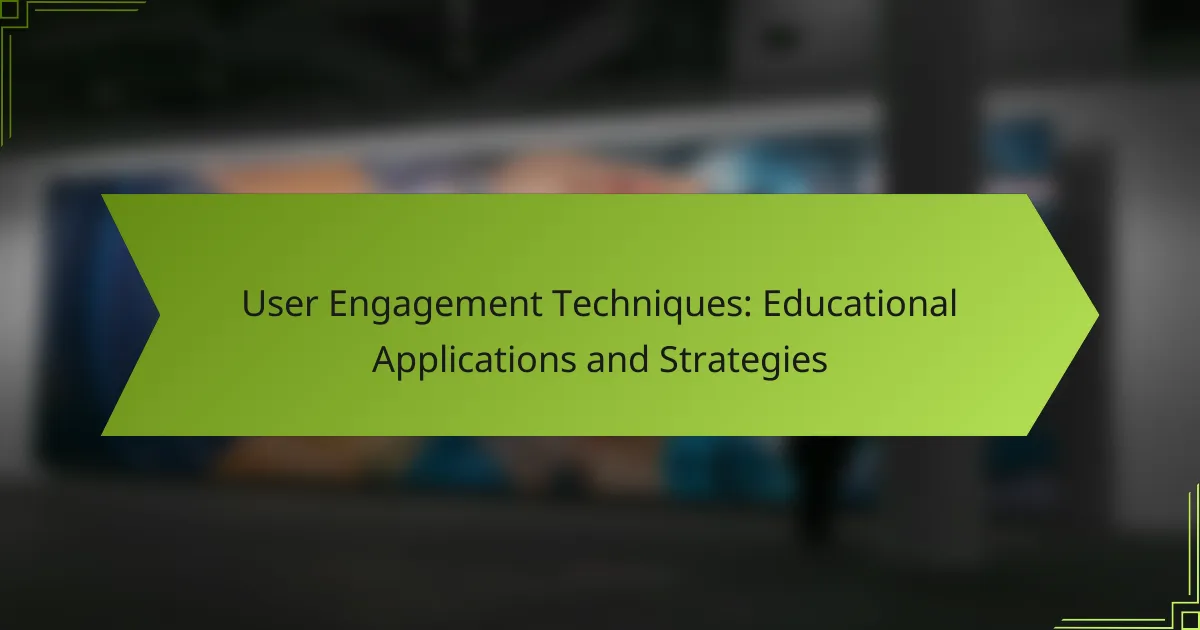User engagement techniques in education are essential for actively involving learners and enhancing their overall experience. By leveraging technology and interactive tools, educators can create personalized learning environments that cater to various learning styles. Additionally, social media plays a crucial role in fostering collaboration and community, further enriching the educational journey.
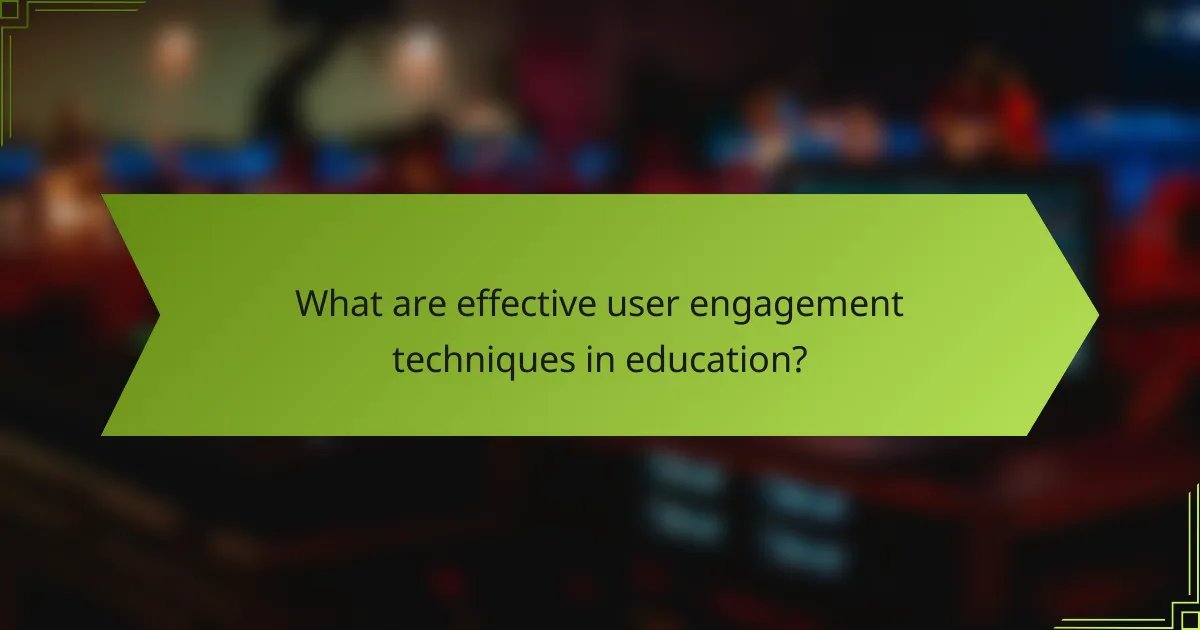
What are effective user engagement techniques in education?
Effective user engagement techniques in education focus on actively involving learners in the learning process. These strategies enhance motivation, improve retention, and foster a deeper understanding of the material.
Interactive learning activities
Interactive learning activities encourage students to participate actively rather than passively absorb information. Techniques such as quizzes, simulations, and hands-on experiments can significantly boost engagement. For instance, using online platforms that allow real-time feedback can enhance the learning experience.
Consider incorporating tools like interactive whiteboards or educational apps that facilitate group discussions and problem-solving. These activities not only make learning enjoyable but also promote critical thinking skills.
Gamification strategies
Gamification strategies apply game-like elements to educational settings to increase motivation and engagement. This can include point systems, badges, and leaderboards that reward students for their achievements. For example, a classroom might implement a points system where students earn rewards for completing assignments or participating in discussions.
When designing gamified experiences, ensure that the challenges are appropriate for the age group and skill level. Balancing competition with collaboration can help maintain a positive learning environment.
Collaborative projects
Collaborative projects involve students working together to achieve common goals, fostering teamwork and communication skills. Group assignments or peer-to-peer teaching can enhance understanding and retention of the subject matter. For instance, students might collaborate on a research project, sharing responsibilities and insights.
To maximize effectiveness, clearly define roles within the group and set specific objectives. This structure helps students stay focused and accountable, leading to a more productive learning experience.
Personalized feedback systems
Personalized feedback systems provide tailored responses to students based on their individual performance and learning styles. This approach helps learners understand their strengths and areas for improvement. For example, using learning management systems that track progress can facilitate timely and specific feedback.
Encourage regular check-ins and one-on-one sessions to discuss feedback. This interaction can motivate students to take ownership of their learning and make necessary adjustments to their study habits.
Multimedia resources
Multimedia resources incorporate various formats such as videos, podcasts, and interactive graphics to cater to different learning preferences. These resources can make complex topics more accessible and engaging. For instance, a video tutorial can effectively explain a difficult concept in a more digestible format.
When selecting multimedia content, ensure it aligns with the curriculum and enhances the learning objectives. Additionally, consider the accessibility of these resources to accommodate all students, including those with disabilities.
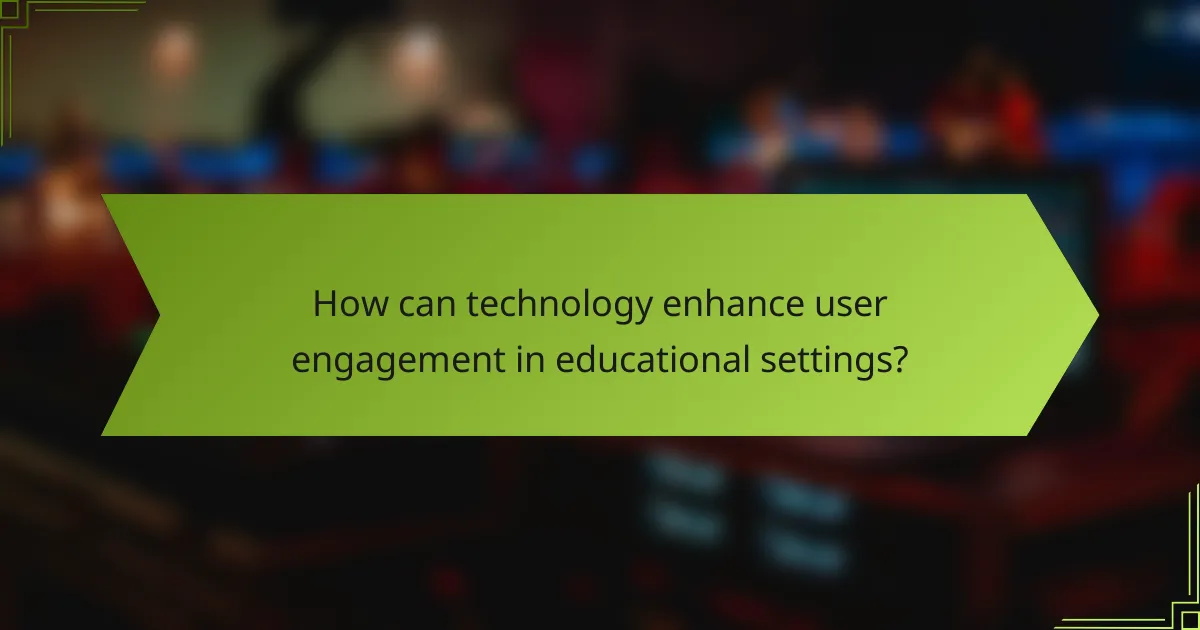
How can technology enhance user engagement in educational settings?
Technology can significantly enhance user engagement in educational settings by providing interactive and personalized learning experiences. Tools such as learning management systems, virtual reality applications, and mobile learning platforms create dynamic environments that cater to diverse learning styles and preferences.
Learning management systems
Learning management systems (LMS) streamline the educational process by enabling educators to deliver content, track progress, and facilitate communication. These platforms often include features like quizzes, discussion forums, and progress tracking, which keep learners actively involved in their education.
When selecting an LMS, consider user-friendliness, integration capabilities with existing tools, and the availability of analytics to monitor engagement. Popular options include Moodle, Canvas, and Blackboard, each offering unique features to enhance user interaction.
Virtual reality applications
Virtual reality (VR) applications immerse users in simulated environments, making learning more engaging and memorable. By allowing students to explore complex concepts in a 3D space, VR can enhance understanding and retention of information, particularly in subjects like science and history.
To effectively implement VR in education, ensure that the technology is accessible and aligns with learning objectives. Consider using platforms like Oculus or Google Expeditions, which provide a range of educational experiences that can be integrated into the curriculum.
Mobile learning platforms
Mobile learning platforms enable users to access educational content anytime and anywhere, promoting flexibility and convenience. These platforms often include interactive features such as quizzes, videos, and discussion boards, which can enhance engagement through immediate feedback and collaboration.
When choosing a mobile learning platform, look for compatibility with various devices and offline access options. Popular tools like Duolingo and Khan Academy offer engaging content that can be accessed on-the-go, making learning more accessible for users with busy schedules.
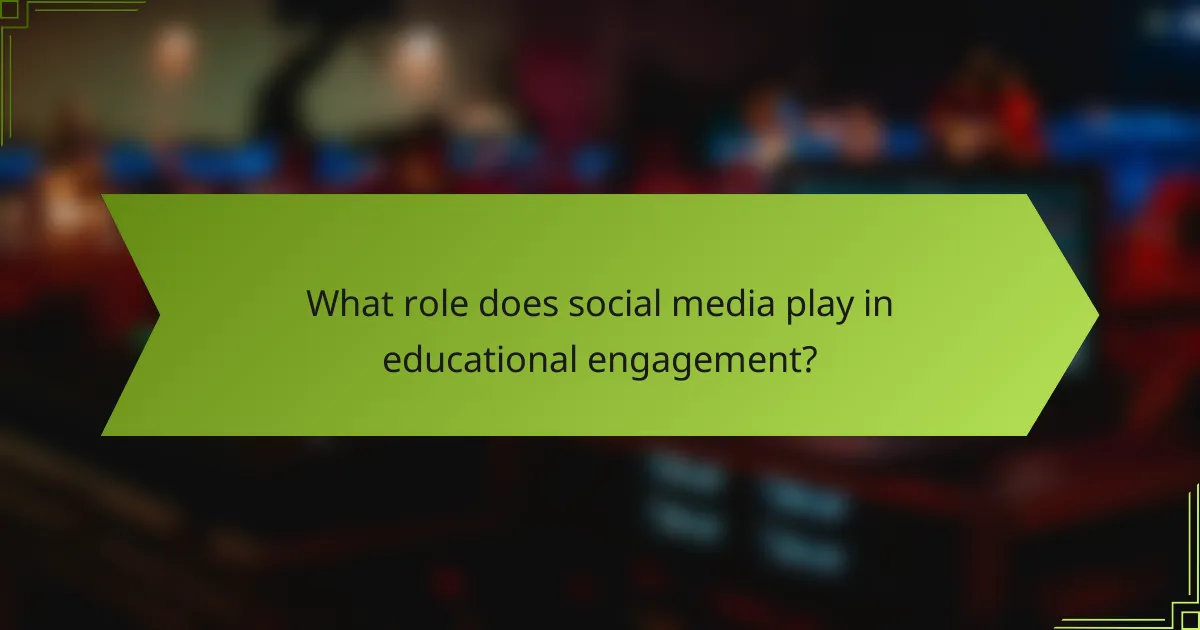
What role does social media play in educational engagement?
Social media enhances educational engagement by fostering interaction, collaboration, and community among students and educators. It serves as a platform for sharing resources, providing feedback, and building relationships that support learning.
Community building
Social media platforms create virtual communities where students can connect, share experiences, and collaborate on projects. These communities can range from small study groups to large forums dedicated to specific subjects or interests.
Encouraging participation in these online groups can lead to increased motivation and a sense of belonging. Educators can facilitate community building by creating dedicated pages or groups that focus on course content and peer support.
Real-time feedback
Social media allows for immediate feedback on assignments and discussions, which can enhance the learning process. Students can post questions and receive responses from peers or instructors within minutes, promoting a dynamic learning environment.
To maximize the benefits of real-time feedback, educators should encourage students to engage actively on these platforms and provide clear guidelines on how to give constructive criticism. This can help create a culture of open communication and continuous improvement.
Content sharing
Social media facilitates easy sharing of educational content, such as articles, videos, and infographics. This not only enriches the learning experience but also allows students to access diverse perspectives and resources beyond their textbooks.
Educators can leverage content sharing by curating relevant materials and encouraging students to share their findings. Establishing a regular schedule for sharing can keep the community engaged and informed about new developments in their fields of study.

What are the benefits of user engagement techniques?
User engagement techniques significantly enhance the learning experience by fostering active participation and interaction. These methods lead to improved educational outcomes, making learning more effective and enjoyable for students.
Improved retention rates
User engagement techniques can lead to higher retention rates among learners. When students actively participate in their learning process, they are more likely to remember the material. Techniques such as interactive quizzes, discussions, and hands-on activities can help reinforce knowledge retention.
For example, incorporating gamification elements into lessons can increase engagement and make information more memorable. Research suggests that students who engage with content through varied methods retain information better than those who passively consume it.
Increased motivation
Engaging users effectively boosts their motivation to learn. When students find learning enjoyable and relevant, they are more inclined to participate actively. Techniques like personalized learning paths and immediate feedback can significantly enhance motivation levels.
Consider using project-based learning, where students work on real-world problems. This approach not only motivates learners but also helps them see the practical applications of their studies, making the learning experience more meaningful.
Enhanced critical thinking
User engagement techniques promote critical thinking by encouraging learners to analyze, evaluate, and create rather than just memorize information. Activities like debates, case studies, and collaborative projects challenge students to think deeply about the subject matter.
For instance, implementing problem-solving tasks that require students to work together to find solutions can enhance their analytical skills. This collaborative approach not only fosters critical thinking but also prepares students for real-world challenges where teamwork and innovation are essential.
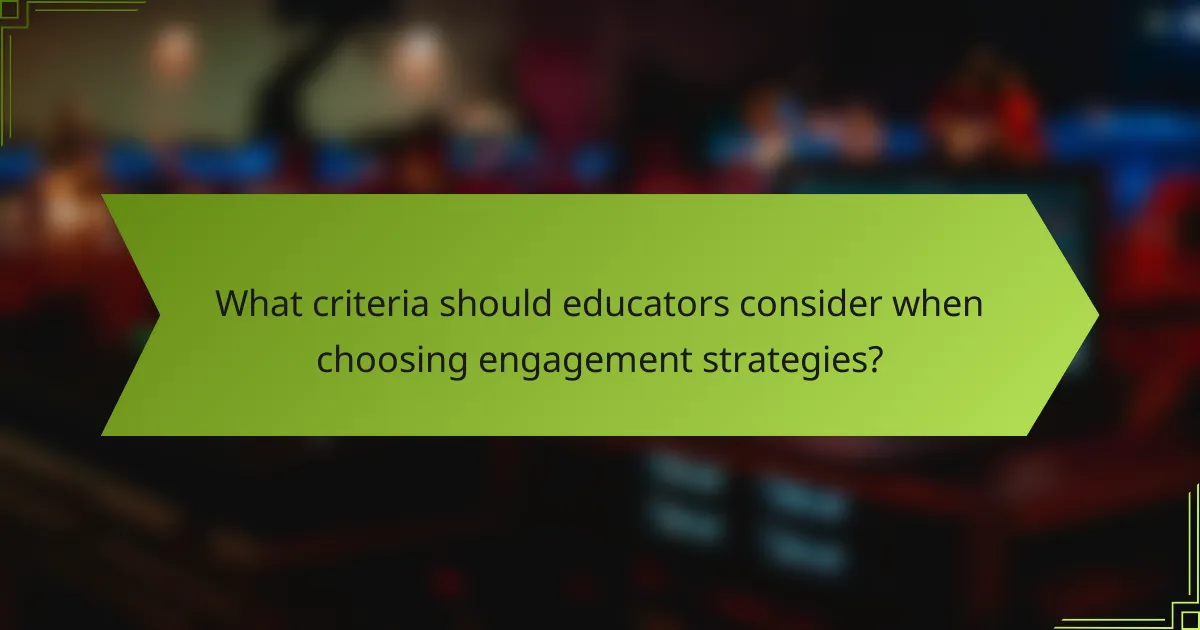
What criteria should educators consider when choosing engagement strategies?
Educators should evaluate several key criteria when selecting engagement strategies, including the needs of the target audience, the availability of resources, and the alignment with learning objectives. These factors ensure that the chosen methods effectively enhance student involvement and learning outcomes.
Target audience needs
Understanding the needs of the target audience is crucial for effective engagement. Different age groups, learning styles, and cultural backgrounds can significantly influence how students interact with educational content. For instance, younger students may benefit from gamified learning experiences, while adult learners might prefer practical, real-world applications.
To assess audience needs, educators can conduct surveys or focus groups to gather insights. This feedback can guide the selection of strategies that resonate with students, fostering a more engaging learning environment.
Resource availability
Resource availability plays a vital role in determining which engagement strategies can be implemented. Educators must consider the tools, technology, and time they have at their disposal. For example, if a school has limited access to technology, strategies that rely heavily on digital platforms may not be feasible.
Additionally, budget constraints can affect the choice of materials and activities. Educators should prioritize low-cost or free resources, such as open educational resources (OER), to maximize engagement without exceeding financial limits.
Learning objectives alignment
Engagement strategies should align closely with the learning objectives of the course or program. This alignment ensures that the chosen methods not only captivate students but also facilitate the achievement of specific educational goals. For instance, if the objective is to enhance critical thinking, strategies that promote discussion and debate would be more effective.
Educators can create a checklist to evaluate whether a strategy meets their learning objectives. This checklist can include questions such as: Does this strategy encourage active participation? Will it help students develop the required skills? By ensuring alignment, educators can enhance both engagement and learning outcomes.
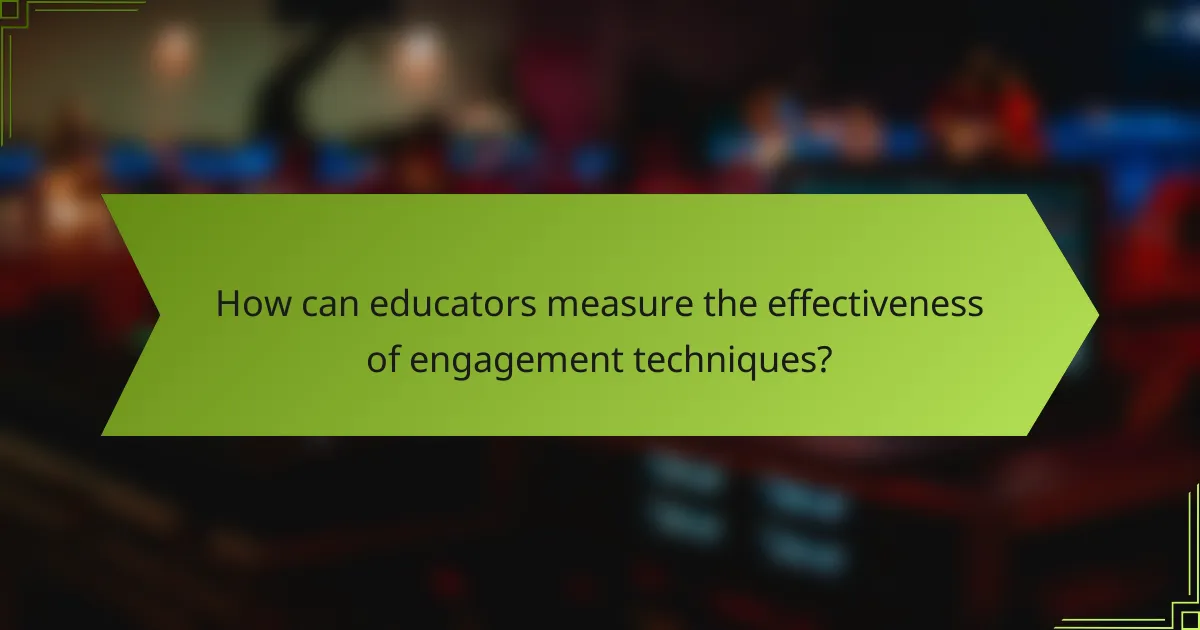
How can educators measure the effectiveness of engagement techniques?
Educators can measure the effectiveness of engagement techniques through various methods, including student feedback, performance metrics, and observational assessments. These approaches provide insights into how well students are interacting with the material and participating in the learning process.
Student Feedback
Collecting student feedback is a direct way to gauge engagement. Surveys and questionnaires can ask students about their interest levels, understanding, and overall enjoyment of the learning activities. Aim for a mix of quantitative ratings and qualitative comments to capture a comprehensive view.
Consider using tools like Google Forms or SurveyMonkey to facilitate anonymous responses. This can encourage honesty and provide more accurate insights into student experiences.
Performance Metrics
Performance metrics, such as test scores and assignment completion rates, can indicate how engagement techniques impact learning outcomes. Tracking these metrics over time allows educators to see trends and make data-driven decisions about which strategies are most effective.
For example, if a specific interactive activity leads to a noticeable increase in test scores, it may be worth incorporating it more frequently. Regularly reviewing performance data can help identify both successful and underperforming techniques.
Observational Assessments
Observational assessments involve watching students during lessons to assess their engagement levels. Note behaviors such as participation in discussions, collaboration with peers, and attentiveness. This qualitative data can complement quantitative measures, providing a fuller picture of student engagement.
When conducting observations, consider using a structured rubric to ensure consistency. This can help identify patterns in student behavior and inform adjustments to teaching methods.
